NEONATOLOGY ON THE WEB
The Nursling
Lecture 6
By Pierre Budin, Professor of Obstetrics, University of Paris; Director
of the Clinique Tarnier; Member of the Academy of Medicine, Paris, France. Authorized
translation by William J. Maloney, M.B., Ch. B., 1907.
Gentlemen:
We shall proceed to the study of the feeding of infants after
their departure from hospital.
The newly born should be put to the breast; an infant ought to be
nourished by its mother. This is the general rule, and it has but few
exceptions.
The mortality of infants is unfortunately considerable. In 1878
Bergeron wrote:
"Without doubt, the first months, and especially the
first weeks of life, against which so many causes of disease and
death conspire, will always, no matter what we do, yield a higher
proportion of deaths than any other period excepting extreme old age.
Is it not humiliating, however, for our country and for our
generation that, in spite of public and individual hygiene, the
mortality among the newly born is such that one can say, without fear
of contradiction, that an infant just born has less chance than a man
of ninety of living a week, and than an octogenarian of living a
year?"
Infantile mortality has certainly in later years decreased, but
much still remains to be done. The beginning is always the most
dangerous period of an infant's life. If its feeding then is not
directed with the utmost care, grave symptoms soon appear and the
infant dies; sufficient proof of this statement is found in the high
death-rate among children entrusted to wet-nurses. We, therefore,
strive to continue to guide in the rearing of their little ones the
mothers who have been delivered in this hospital. Our one aim is to
secure by advice, by encouragement, and by the use of every means in
our power the rearing of the infant at its mother's breast.
Unfortunately some women have no milk and others have not sufficient.
We do our best to help them by supplementing their efforts, and it is
only when it is absolutely impossible to do otherwise that we have
recourse to artificial feeding.
Immediately after birth a child loses weight. In about ten days,
however, this loss is retrieved, and the average rate of growth is
such that if the child weighed 3250 grams at birth, it would reach
about 9000 grams at the end of its first year. This growth varies
with the age, and is not always accomplished at the same rate. It is
rapid at the beginning and becomes less and less as age advances.
Here are the figures given by Bouchard:--
|
|
Birth
|
1 Month
|
2 Months
|
3 Months
|
4 Months
|
5 Months
|
6 Months
|
7 Months
|
8 Months
|
9 Months
|
10 Months
|
11 Months
|
12 Months
|
|
Augmentation
|
---
|
750
|
700
|
650
|
600
|
550
|
500
|
450
|
400
|
350
|
300
|
250
|
200
|
|
Average Weight
|
3250
|
4000
|
4700
|
5350
|
5950
|
6500
|
7000
|
7450
|
7850
|
8200
|
8500
|
8750
|
8950
|
From this it follows that the increase is approximately--
From 25 to 30 grams per day during the first two
months.
From 20 to 25 grams per day during the 3rd and 4th months.
From 15 to 20 grams per day during the 5th and 6th months.
From 10 to 15 grams per day during the 7th and 8th months.
From 8 to 10 grams per day during the remainder of the first year.
Notice, however, that during the last twenty days of the first
month the infant augments more than 25 to 30 grams per day; for it if
weighs 3250 grams at birth, and does not again reach this figure till
the tenth day, the 750 grams are thus gained in twenty days, so the
actual growth is at a rate of 37.5 grams per day.
It must not be forgotten that these are only average figures. It
is generally necessary to take an average of several days, as
variations, more or less considerable, occur from day to day
according as the infant's bowels move freely, or not, or as its daily
weighing takes place after a large or small meal.
At the end of one year the infant who weighed 3250 grams at birth
will reach about 6000 grams.
I have [in previous lectures] represented graphically the progress
of the average infant's weight during the first year. A reproduction
of this on a larger scale is used at our Consultations. If a point be
placed each week on this chart, in the space corresponding to the
weight and age of the infant, the joining of these points will show
the curve of its growth, and by comparison, whether it is inferior,
equal, or superior to the normal. These charts are of great service,
both in hospital and in private practice.
I do not wish, gentlemen, to enter into all the details of the
breast-feeding of infants, for they can be found in most text-books
of midwifery. I shall content myself with calling your attention to
some of the more interesting particulars.
In certain cases a mother's milk may be injurious to her infant.
This may happen when she has experienced some violent emotion; when
she is in bad health; and when her milk has an abnormal composition.
Let us examine these various conditions.
There is no doubt that acute mental emotion can affect the lacteal
secretion.
The son of a medical friend of mine had an excellent wet-nurse,
and was developing regularly. News came, however, of the illness,
and, later, of the death of the poor woman's own child. The nursling
at once had diarrhoea, and in a few days lost 240 grams. Not many
days after the milk regained its good qualities, and the infant
became better, and once more began steadily to increase
(Fig. 61).
In sensitive women, any analogous occurrence, by bringing about a
modification in the composition of their milk, may injuriously affect
the health of their nurslings. This is the reason why nervous mothers
are so often poor nurses.
But you may object, "Are you sure that such facts are not mere
coincidences? Are you certain you have not overlooked the real
cause?" The reproduction of these phenomena in several infants
simultaneously would verify the cause alleged; thus, if a wet-nurse
was giving the breast at the same period to several infants, if these
infants were suckled exclusively by her, and if they all presented on
the same day modifications in their health and weight, this
simultaneous appearance of symptoms would obviously constitute an
indisputable proof of the cause under the influence of which they
were suffering in common.
I had an opportunity of observing such a demonstration at the
Maternité.
The wet-nurse E____, besides feeding her own child, was suckling
two nurslings, and all were progressing normally. In the afternoon of
September 20, 1895, she had a violent fit of temper, and next morning
her infant had diarrhoea, but its actual diminution could not be
ascertained, as it was not weighed every day. The weaklings, however,
both showed a distinct loss of weight
(Fig. 62).
No. 275, infant Jean L____, born on July 27, 1895, was brought to
the Maternité with a weight of 1290 grams, and a temperature
of 36° C., on August 1; on September 20 he weighed 2160 grams.
On that day the wet-nurse had her outbreak, but the next the nursling
had lost 30 grams. During the following days its curve again rose
regularly, and it left the hospital in good health.
No. 279, infant Louis N____, born on July 6, 1895, was brought to
the Maternité on August 3, with a weight of 1880 grams, and a
temperature of 36.3° C. He grew steadily. On September 20 he
lost 50 grams, and on the 21st, the day after the wet-nurse's
tantrum, continued to decrease. On the 22nd he began to progress once
more, and in due course left the hospital in perfect health.
Observe the quantities of milk taken daily by each infant from
September 15 to 23:--
|
Date
|
No. 275
|
No. 279
|
Total
|
|
September 15
|
400 grams
|
480 grams
|
880 grams
|
|
" 16
|
430
|
580
|
1010
|
|
" 17
|
470
|
500
|
970
|
|
" 18
|
450
|
520
|
970
|
|
" 19
|
500
|
530
|
1030
|
|
" 20
|
430
|
510
|
940
|
|
" 21
|
470
|
540
|
1010
|
|
" 22
|
450
|
550
|
900
|
|
" 23
|
480
|
530
|
1010
|
The quantity ingested cannot be blamed, for not less milk was
taken from September 20 to 21 than on the preceding days.
But I told you that the infant of the wet-nurse had diarrhoea. On
the charts of the two weaklings between September 22, after the
morning visit, and September 23, at the same hour, the following were
the notes: No. 275, "Stools green, diarrhoea during the night;" No.
279, "Stools liquid, yellow."
There seems to be little doubt that the passion of anger which
arose in this wet-nurse so modified her milk as to render it
injurious to her three nurslings.
Great fatigue has a similar effect. You may remember that my first
knowledge of an attack of influenzal bronchitis among the offspring
of the wet-nurses was due to my inquiring why most of the weaklings
had lost weight overnight. The reason, I found, was that the
wet-nurses were worn out through attending to their own suffering
little ones.
Sickness may exercise somewhat the same influence. A wet-nurse,
F____ A____, aged 29, delivered on December 15, 1894, had charge of
three infants, Nos. 209, 315, and 343, on October 23, 1895. On
October 24 she was unwell all day. By the next morning all three
infants had lost weight (Fig. 63).
No. 209, Baby Az_____, born on June 14, 1895, had steadily
increased, and on October 23 weighed 2600 grams. On the 24th he
weighed only 2550 grams; he had lost 50 grams in twenty-four hours.
Next day his curve again began to rise regularly, and he was
discharged in perfect health weighing 2700 grams.
No. 315, the weakling Pierre R____, born on August 29, 1895,
weighed on October 23, 2060 grams. On October 24 he weighed no more
than 2020 grams, having lost 40 grams in twenty-four hours. On the
next day he began to increase again, and later, with a weight of 2820
grams, left hospital in good health.
No. 343, Pierre T_____, born on September 22, 1895, had been
progressing steadily, and on October 23 weighed 1820 grams. On
October 24 his weight fell to 1800 grams, and on the 25th it was only
1790. Then he recommenced to augment normally. On January 1, 1896, he
had attained 2135 grams, when he succumbed to an attack of
bronchitis.
Tabulating the quantities of milk taken by each of these
weaklings, we find:--
|
Date
|
No. 343
|
No. 209
|
No. 315
|
Total
|
|
October 19
|
420
|
630
|
460
|
1510
|
|
" 20
|
470
|
660
|
490
|
1520
|
|
" 21
|
440
|
660
|
530
|
1630
|
|
" 22
|
450
|
630
|
500
|
1580
|
|
" 23
|
480
|
700
|
460
|
1640
|
|
" 24
|
430
|
600
|
480
|
1510
|
|
" 25
|
420
|
590
|
460
|
1470
|
|
" 26
|
430
|
590
|
490
|
1510
|
|
" 27
|
450
|
680
|
480
|
1610
|
|
" 28
|
530
|
600
|
490
|
1620
|
There seems to have been a slight diminution in the amount
furnished by the wet-nurse from October 23 to 24. Her indisposition
appears to have affected not only the quality but also the quantity
of her milk.
If the chemical composition of the mother's milk differs markedly
from the normal, the health of the nursling may suffer. In speaking
of weaklings I pointed out that if they received the last of the
breast contents, a milk rich in butter, their stools sometimes became
liquid and only partially digested, and analysis showed that the
faeces were loaded with fat. Among full-term infants similar cases
occur.
In November 1898, for example, we analysed, in this Clinique, the
milk of a wet-nurse, Let_____, because the infants entrusted to her
had digestive troubles: it contained 61.21 grams of butter per litre.
An infant born on January 22, 1899, in the Rue Magdebourg had
copious, badly-digested motions, and sometimes diarrhoea. The
wet-nurse's milk at the beginning, middle, and end of a feed was
collected and analysed on February 13. Each litre contained 165 grams
of solids, of which 80.4 grams were butter. By changing her
régime I endeavoured to influence the composition of her milk,
but on February 24 it was found still to contain nearly 50 grams of
butter. The child's condition did not improve, so I was forced to get
him another wet-nurse; a few hours after her advent he ceased to cry
and slept peacefully, and two days later his stools became normal.
Some time afterwards the chief of my laboratory, M. Michel, had
occasion to examine the milk of a wet-nurse in the service of Madame
D____, Rue Taitbout, because the nursling had diarrhoea. This milk
contained 66.40 grams of butter per litre. On inquiry I learned that
this was the identical wet-nurse whose milk I had previously analysed
when she was employed in Rue Magdebourg. [1]
On the other hand, infants sometimes ingest milk containing an
insufficient amount of nutriment. That which first flows from an
over-distended breast is of this nature. Infants drink great
quantities of it; they pass plenty of urine but scarcely increase in
weight.
Again, a milk may be too rich in sugar, and here the hygiene of
the wet-nurse seems to be a powerful factor. There have been two
women attending my Consultations whose children, fed exclusively at
the breast, suffered from eczema. One of them, named Sa____, was
delivered at the Maternité on October 1, 1897; she left on
October 12, when her infant weighed 4375 grams. He continued to
increase, and his curve became greatly superior to the normal
(Fig. 64). The eczema first appeared
on February 12. The mother was a big, stout woman; she ate meat twice
every day, drank excessive quantities of wine, and took no exercise.
Hitherto, she had been impervious to advice, but now, alarmed by the
result of her folly, she modified her habits; meat was eaten but once
a day, wine was replaced by milk and mineral waters, and a daily
promenade of an hour and a half to two hours was obediently
undertaken. The infant had continued to increase in weight, but at a
reduced rate. Its curve, which previously was beyond the normal, now
approximated to it, but, when the eczema was cured, it rose again to
surpass the average.
I could cite other examples of the same kind from my private
practice. When mothers will lead well-regulated lives as regards food
and exercise, and infants cease to be overfed, eczema will be
eliminated from the afflictions of nurslings.
Infants suckled by wet-nurses addicted to alcohol are sometimes
subject to alarming seizures. Charpentier, Vallin, and others have
published interesting cases; here is one to which I was recently
called. A foreign lady on a visit to Paris was, on the alleged advice
of her medical attendant, indulging in large quantities of quinine
wine, which, in order further to fortify herself, she supplemented by
bordeaux, champagne, liqueurs, beer, &c. She was suckling her
baby, then five weeks old. Since birth it had increased on an average
by 30 grams per day, till it weighed nearly 6000 grams. During the
night it had taken a convulsion; in the morning a second followed,
and I was hastily summoned. I learned that for several days it had
been restless and sleepless. As the child, on examination, seemed
free from disease, I suspected the symptoms were due to the mother's
peculiar régime. But all doubts disappeared, when a still more
violent fit followed the infant's again being put to the breast. This
attack lasted an hour, and was characterised by periods of convulsive
movement supervening on a more or less constant state of rigidity.
There were fifteen subsequent seizures, which I controlled with
chloroform. The maternal feeding was suppressed, a wet-nurse was
obtained, and the little one was quickly cured. In three days it had
lost 200 grams, which, however, it quickly regained, and soon it
began to enjoy the proverbial calm sleep of infancy for the first
time in its life.
It is a general idea that once her menses reappear a woman becomes
a poor nurse. At the actual menstrual periods her milk may not always
be well tolerated. Twenty-three years ago Dr. Ségond and I
diagnosed the re-establishment of menstruation in a wet-nurse from
periodic disturbances in the health of her charge, and since then I
have frequently made similar observations.
The wet-nurse, J___, was suckling two infants at the
Maternité in 1895. They were progressing satisfactorily, when
in both an erythema of the buttocks appeared, with diminution of
weight (Fig. 65). The probability that
the wet-nurse was menstruating immediately suggested itself, and
inquiry made it an acknowledged fact. These two infants suffered to
such an extent that I had to give them to another wet-nurse.
One of them, No. 250, baby M___ L___, born on July 11, 1895, was
brought to the Maternité on July 12, with a weight of 1280
grams and a temperature of 36.9° C. On October 11 he weighed
2425 grams; on the 12th, the day the wet-nurse was found to be
menstruating, 2390; on the 13th, the date of the first appearance of
the erythema, 2370; on the 14th, 2335; and on the 15th, 2380 grams;
then the weight remained stationary, and as the erythema persisted, I
changed the wet-nurse. Not till October 20 did the erythema
completely disappear.
The other, No. 295, infant L___ G___, born on August 10, was
admitted to the Maternité on August 11. He steadily increased,
so that the 1400 grams he weighed at entry had by October 11 become
2180 grams. We were then surprised to discover an erythema of his
buttocks. On October 12, the day the wet-nurse acknowledged she was
"unwell," he had fallen to 2170 grams. He increased again for two
days, and then began persistently to diminish. The erythema,
moreover, did not improve, so it was resolved to change his
wet-nurse. The infant then recommenced to increase, and on October 20
the erythema disappeared. In the course of time he attained a weight
of 2675 grams, but he succumbed in an epidemic of bronchitis on
December 14.
This was a particularly illustrative instance, as it happened in a
woman suckling two infants, who both became ill simultaneously when
she began to menstruate.
I shall now briefly allude to a series of cases which I have
observed at the Consultation, and which show how nurslings may be
affected when they are suckled by mothers who menstruate regularly.
A woman named Joul____ was delivered at the Clinique on September
5, 1898, of an infant weighing 4020 grams. He was breast fed with
excellent results, his curve from the beginning being above the
average (Fig. 66). The mother
menstruated on November 4, December 30, February 10, March 10, and
April 21. The infant did not suffer to any extent at the date of the
mother's periods excepting on two occasions; on February 10 and March
10 he had diarrhoea with green stools. Otherwise he seemed quite
unaffected, but his curve gradually lost its excellence, till it
became inferior to the normal which, at first, it had so far
surpassed.
A patient called Calm____ was delivered here on August 5, 1898.
The infant was fed by his mother, and his curve was far above the
average. The woman menstruated on September 30, November 11, January
10, and March 24. At each of these periods the infant lost weight; on
March 24 his motions became frequent, liquid, and green, without any
ascertainable cause other than the mother's state; and the general
aspect of his curve gradually deteriorated, approximating more and
more to the normal. Further, the mammary secretion became rapidly
insufficient, so that from September 30, it was necessary to give the
infant 160 grams of sterilised cows' milk per day. As the maternal
supply continued to diminish, this allowance had to be increased,
till on January 13 it reached 240 grams
(Fig. 67).
A patient named Go_____ was delivered in our wards on January 2,
1898, of a weakling who weighed 2350 grams. He was breast-fed, and
for ten weeks all went well. Her menses reappeared on February 12,
and returned on March 12, April 16, May 20, June 17, &c. The
infant, as the curve shows (Fig. 68),
diminished in weight during only one of those periods. Nevertheless,
the mother was far from being a good nurse.
I do not wish from these cases to conclude that menstruating women
are always bad nurses, and that it is preferable that they should not
suckle. This would not be at all justifiable. If in some infants
diarrhoea supervenes, and in others the weight diminishes, in others
again there is no appreciable change in health. Exclusive maternal
feeding may thus sometimes be continued with complete success, but
more frequently it is necessary to supplement the insufficiency of
the mother's secretion with cows' milk.
It is well, however, to know these details, in order to be able to
distinguish the true cause of troubles temporarily arising in an
infant's health. We shall not only be spared undue anxiety, but also
be enabled, when necessary, to apply the appropriate remedy.
It is the current belief throughout France that the milk of a
pregnant woman is harmful, and therefore, when a nursing mother
thinks she has conceived, she straightway ceases to suckle. Many
facts made me suspect that this opinion was without foundation, so I
requested one of my pupils, Dr. Poirier, to accumulate the necessary
data to enable us to arrive at a definite conclusion.
He collected fifty-one observations, and found that in 72 per
cent. of cases nursing by a pregnant woman occasioned no disturbance
to the health of the infant.
In 8 per cent., no rigorous conclusion could legitimately be drawn
from the observations.
In 20 per cent., the infants manifested such symptoms as
necessitated immediate weaning.
As Dr. Poirier remarks, "In order definitely to settle the
question we require to know in what proportion of cases non-pregnant
nursing mothers are able to complete the suckling of their
offspring."
My personal experience enables me to confirm the observations of
Dr. Poirier.
In one case a nursing mother came to consult me at the
Charité. She had felt a sensation which she described as
resembling "quickening," but as the baby at her breast was in
excellent health, she could not believe herself pregnant. On
examination I found her advanced about four and a half months. The
chemical composition of her milk was found to be absolutely normal.
As I wished to photograph the infant, and to make another analysis of
the milk, she promised to return in a few days; but scarcely had she
crossed the threshold of the hospital, when she allowed a neighbour
to persuade her that the pregnancy would surely have an injurious
effect on the child at her breast. She sought the advice of a
herbalist, and he sold her some drugs to dry up her milk. When next I
saw the child he was completely weaned, and he looked so thin and ill
that I could hardly recognize him. So striking was the contrast that
I greatly regretted that I had not taken the photograph on his first
visit.
In the great majority of cases the appearance of pregnancy in a
nursing mother gives rise to no unfavourable symptoms in her infant,
but, especially in large towns, there is always a question of the
fitness of the mother to bear with impunity the simultaneous strains
of nursing and pregnancy.
Sutils, [2] who from the wealth of his experience
has collected twenty-six observations of pregnancy during nursing,
has arrived at conclusions analogous to those I have just stated.
According to him the milk of a pregnant woman may be insufficient in
amount, but it is entirely free from any noxious influence on her
nursling. He reports, among others, the two following cases:--
In the first (Fig. 69), the mother
was cognisant of her pregnant state, but the infant was not weaned
till the eighth month. Obviously, it did not suffer from the mother's
condition, as its curve excels the average.
In the second (Fig. 70), the mother
to begin with tried to rear her infant at the breast, but had not
enough milk; she then fed it artificially, but as it did not thrive,
it was handed over to a breast wet-nurse, whom it vigorously sucked.
The wet-nurse became pregnant, and her milk supply having diminished,
the child made almost no progress. It was then given to a second
wet-nurse, who also became pregnant; in this case, however, the milk
continued to flow freely, and the infant steadily prospered.
I think we are justified in concluding that the popular belief
that pregnant women are dangerous wet-nurses has no foundation in
fact.
Pathological conditions in the mother are generally thought to
contraindicate nursing. There is no doubt that some diseases, such as
phthisis and acute pulmonary
infections, do necessitate its suspension, but if artificial feeding
be well directed from the beginning, the infant may continue to
progress favourably. For example, on December 6, 1897, a woman named
Mav____ was delivered of her third daughter; she had reared the
others at the breast, and had also faithfully brought them to my
Consultation. So well did the infant thrive that its curve was above
the average. On May 18, however, it lost 150 grams on the
reappearance of the mother's menses. On June 3 I was told, when the
infant was brought to me, that, as the mother was attacked with acute
pleurisy, her doctor had forbidden nursing. The child was ordered
eight bottles of pure sterilised milk per day, each of which held 75
grams, or 600 grams in all. On June 10 I found that the infant was
in no way the worse of being weaned, and that her stools were quite
normal. As she had lost, however, 250 grams, it was evident I had not
given quite enough. Having had her ration increased to nine bottles
of 75 grams each, or 675 grams per day, by June 14 she had gained 170
grams. The mother happily recovered, and the infant, although weaned,
continued to thrive (Fig. 71).
But beyond pulmonary affectations, there are certain other
pathological conditions in which the exact course to be pursued is
still a matter of discussion, and, therefore, in need of further
investigation. For example, what is the correct attitude in cases of
eclampsia or albuminuria, where the albumen persists after delivery?
Ought these women to be allowed to suckle? This is a matter of great
practical importance.
Dumas and Cassin, from their observations, deduced that all women
with albuminuria beyond the third day after delivery ought to cease
to nurse.
Gamulin, in 1896, collected 158 observations at the Clinique
Baudelocque, from which he formulated the following opinion:
"I believe I am justified in concluding that an infant
nourished by an albuminuric mother develops and increases in weight
in the same proportion as other infants.
"Morover, albuminuric mothers who nurse their offspring, even
although they are restricted to milk diet exclusively, derive those
benefits which accrue to every woman who fulfils this physiological
function. Nursing does not expose them to any undesirable
consequences, either as regards their albuminuria, or as regards
their general health.
"It follows, therefore, that every albuminuric mother can and
ought to nurse their child. It is only in those exceptional cases in
which the albuminuria increases or does not diminish during several
weeks that the maternal feeding ought to be suspended. For the rest,
if the infant does not thrive at the mother's breast, which may
happen with these as with healthy women, another nurse may be tried."
With my former assistant, Dr. Chavane, I have studied this
question at the Charité, the Maternité, and here, at
the Clinique Tarnier. [3]
At the Charité there were no wet-nurses, and every woman,
including those who had albuminuria, had therefore to nurse her own
infant, but yet I never saw any untoward results in either mother or
child. From 1895 onwards I successfully continued this practice at
the Maternité, and in renal cases I found the albumen usually
disappeared at the end of several days.
But what happens in cases of persistent albuminuria? Formerly, we
had no information on this point, but, thanks to the Consultation for
Nurslings, I have been able to follow several albuminuric mothers
throughout their whole nursing period. Here are three of my
observations:--
B_____ was brought to the Maternité on January 21, 1895,
having had eclamptic fits. The pregnancy continued till February 10,
when a premature infant, weighing 1430 grams, was born. The
albuminuria continued till May 11, but yet the mother suckled her
child and proved an excellent nurse. On August 3 the infant reached
4800 grams, and its curve steadily rose parallel to the normal
(Fig. 72).
A woman named Dub____, delivered at the Maternité on
February 28, 1897, had severe albuminuria and considerable oedema.
Her infant weighed 2400 grams, and was nourished exclusively at her
breast. Its curve closely follows the normal line
(Fig. 73). Not till after three
months, on May 29, did the albumen completely disappear. By August 14
the infant reached 5500 grams.
A primipara of thirty, named Dup____, who was delivered of twins
on September 7, 1894, had very marked general oedema. The smaller
twin, 2050 grams in weight, lived only for a few hours; the other,
who weighed 2650 grams, was nursed by the mother. As she scarcely had
enough milk, 200, 250, and 350 grams of pure sterilised milk were
gradually added to his daily supply. Although the oedema persisted in
the mother's face for a month, and the albuminuria lasted till the
ninth week, the child flourished splendidly, and soon was beyond the
average weight (Fig. 74).
From my own observations, I am of opinion that women who have
albuminuria, and even those who have had eclamptic fits, are quite
capable of nourishing their offspring. Often the albumen rapidly
disappears, and the nursing follows an uneventful course. Even in a
case of exceptional persistence of albuminuria, nursing can still be
continued without seeming to impede the definite cure of the mother.
When she has not enough milk, her supply should be supplemented just
as in ordinary cases. Needless to say, a careful watch must be kept
over mother and infant, so that if complications arise the
breast-feeding may be at once suspended.
In cardiac disease nursing is clearly contra-indicated. Yet here
is a case in which a mother, although suffering from valvular
disease, insisted on rearing her child at the breast.
A woman named Gaz____, who had mitral incompetence, gave birth
prematurely to twins at the Maternité on October 30, 1896. The
one, Jeanne, weighed 1550 grams; the other, Désirée,
2200 grams. I did not allow the mother to nurse. I placed the little
ones in the department for weaklings, and, in due course, sent them
to the Pouponnière, where they attained 5000 and 5100 grams
respectively. They have both grown into very pretty girls, and are a
source of much pride to their mother.
Having become pregnant again, she gave birth on February 12, 1899,
in our Clinique, to a boy weighing 2350 grams. I intended to entrust
him to one of our wet-nurses, but I yielded to her entreaties and
allowed her to suckle him herself. When she left hospital, I advised
her to feed him on sterilised milk, but, seeing her infant thriving,
and fearing the consequences of changing his diet, she persisted in
rearing him at the breast. When next I saw the infant he was in
splendid health, but the mother was worn out. As it seemed to me that
she was running great risks, I urged her to wean him, but she refused
to do so until I assured her that the change would do her son no
harm.
Should idiots, epileptics, and women with other cerebral
affections be permitted to nurse? Especially with epileptics, the
infant may be exposed to grave dangers. But what is to be done when
the mother is too poor to provide her infant with a substitute? And
what will become of the child if it be entrusted to a mercenary who
is not properly supervised?
Several years ago I allowed an epileptic, a former patient at the
Salpetrière, to suckle her child. During the nursing period
the fits were few, and when she felt their approach she placed her
infant in safety. No harm ever befell him, and he made excellent
progress.
At present, a woman named Des____ is attending our Consultation.
She was delivered here on July 22, 1898. Her facial expression and
general appearance showed her to be a minus habens, almost an
idiot. She left the Clinique on August 6, her baby then weighing 3800
grams. During her convalescence at Vesinet she had not sufficient
milk for her infant's needs; cows' milk was given, with the result
that the infant had diarrhoea. When it returned to me on August 27 it
did not weigh more than 3740 grams (Fig.
75). I continued the breast-feeding, and added per day four
bottles of 50 grams, i.e. 200 grams of pure sterilised milk.
At once the child markedly improved, and, as you see, its curve
became superior to the normal. Later, the infant's progress slowed
and the mother's milk became less, so I increased the amount of
sterilised milk to 400 grams on February 17, 1899, and to 480 grams
on May 5.
You have seen another case, that of the woman Tel____, delivered
at the Maternité in 1896. From the beginning her milk supply
was insufficient, and, as it soon ceased altogether, we had recourse
to artificial feeding. This woman was practically devoid of
intelligence; she rarely seemed to be conscious of her surroundings;
she wandered about not knowing where she went, but she always found
the way to the Maternité. Every day she came to seek her
infant's allowance of milk, and faithfully appeared with her little
one at the times appointed for the Consultation. She kept her baby
very clean and free from harm, and its weight followed practically
the normal curve.
You will sometimes have difficulty in persuading women who are
mentally unsound to obey your counsels. Your efforts, however, are
reinforced by their powerful maternal instincts, and a little
patience will enable you successfully to surmount all obstacles. The
infant is better cared for than if it were confided to a mercenary
stranger, and the mother, although incapable of work, at least
renders the service to society of rearing her own child.
Footnotes
1. P. Budin and Ch. Michel, "Sur l'utilisation des
graisses dans l'organisme du nourrisson." Bulletin de la
Societé d'Obstetrique de Paris, 1899, pp. 191-201.
2. Sutils, "Contribution à l'étude
de l'influence de la grossesse chez les nourrices."
L'Obstetrique, 1898, pp. 60-67.
3. P. Budin et Chavane, "De l'allaitement chez les
femmes qui ont eu de l'albuminuria de la grossesse." Bulletin de
la Societé d'Obstetrique de Paris, March 16, 1899, pp.
84-95.
|
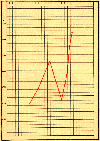
|
Fig. 61. Great emotion in a wet-nurse, causing her
nursling to lose weight.
|
|

|
Fig. 62. Paroxysm of temper in a wet-nurse; effect on the
weights of her nurslings.
|
|
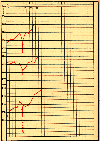
|
Fig. 63. Effect on three nurslings of the illness of
their wet-nurse.
|
|
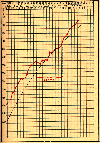
|
Fig. 64. Eczema affecting an infant breast-fed by its
mother. Cured by regulating the mother's mode of living.
|
|
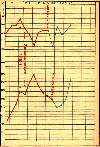
|
Fig. 65. The effect on two nurslings of the milk of a
menstruating wet-nurse.
|
|
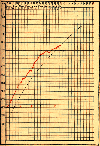
|
Fig. 66. Reappearance of the menses in a nursing mother.
Deterioration of the infant's curve.
|
|
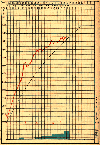
|
Fig. 67. Diminution of the mammary secretion owing to
reappearance of the menses. Cows' milk in progressively
greater quantities had to be added to the infant's diet.
|
|

|
Fig. 68. Effect of menstruation on a nursling's curve.
|
|
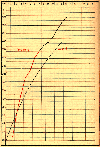
|
Fig. 69. Pregnancy in a nursing mother. Note that in
spite of the mother's condition the nursling's curve was
superior to the normal (Sutils).
|
|
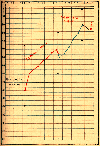
|
Fig. 70. Infant first nourished by its mother, then by
two wet-nurses in succession, each of whom became pregnant
(Sutils).
|
|
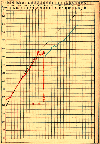
|
Fig. 71. Breast-feeding suppressed, owing to acute
pleurisy attacking the mother. Infant, a girl, fed
artificially. At first too little milk was given and she
lost weight, but when the amount she required was reached
she grew rapidly.
|
|

|
Fig. 72. Eclampsia and premature labor. Albuminuric
mother successfully suckled her child. The red arrow marks
the complete disappearance of the albumen.
|
|
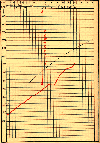
|
Fig. 73. Weight curve of an infant suckled by an
albuminuric mother.
|
|
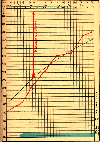
|
Fig. 74. Infant suckled by albuminuric mother. As her
supply was inadequate, mixed feeding had to be practised.
|
|
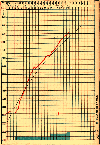
|
Fig. 75. Weight curve of an infant suckled by an idiot.
As she could not furnish enough milk, mixed feeding had to
be adopted.
|
Return to The Nursling Contents Page
Created 2/14/97 / Last modified 2/14/97
Copyright © 1998 Neonatology on the Web / webmaster@neonatology.net














